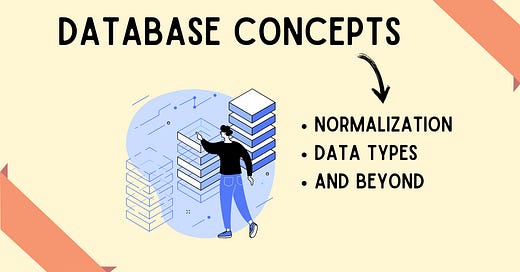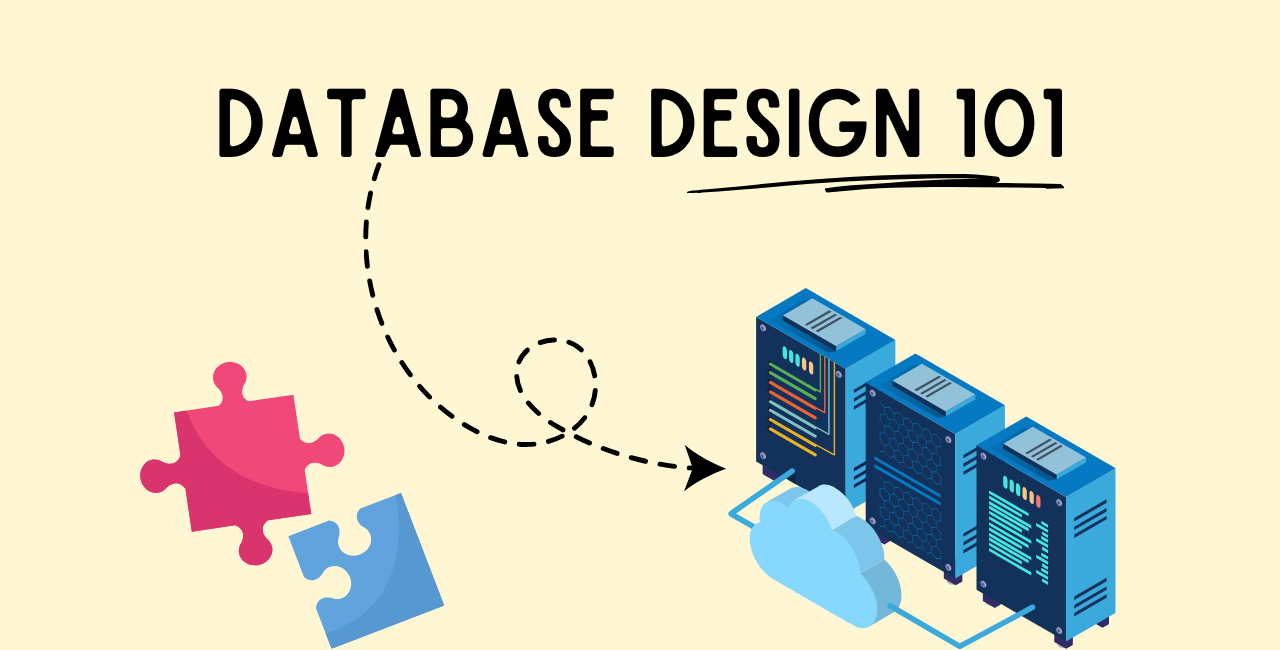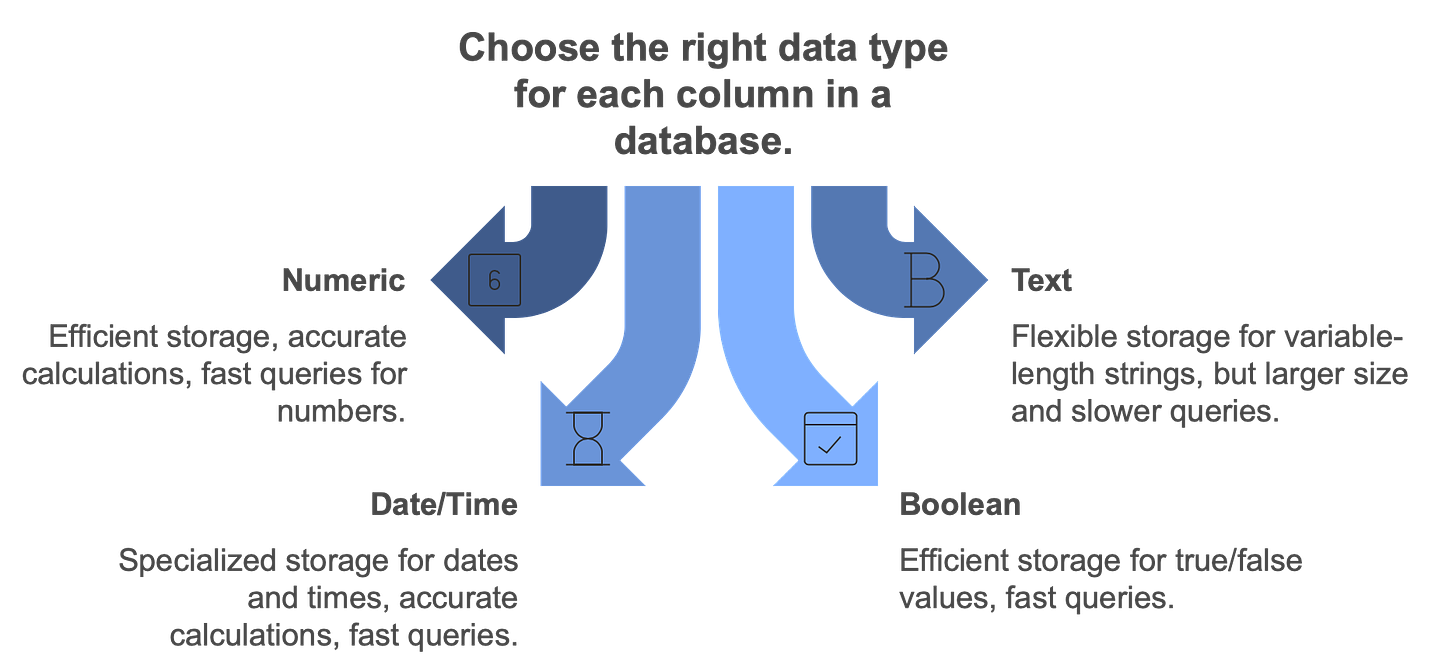Database Design Concepts: Normalization and Data Type in SQL
The Essentials of Database Design: Learn How to Organize, Store, and Access Data Efficiently for Faster Retrieval, Improved Accuracy, and Scalable Growth.
Database design is like setting up a library for your data. It’s the basic plan for how your data will be stored, organized, and accessed, making sure everything stays tidy, easy to find, and secure.
Picture it as laying down the blueprint for how information moves in any system—whether it's just a list of contacts or a full-scale customer database. With solid design, you’re making things smooth and simple for entering new data, finding it quickly, and keeping it up-to-date.
On the other hand, poor design can lead to messy data, wasted time, and bigger costs down the line. As devs we are all about saving time!
In this article, I’ll dig into the core parts of good database design: how to keep data reliable, avoid repeating information, and set things up so you can get to your data fast and easily.
Each week, I dive deep into Python and beyond, breaking it down into bite-sized pieces. While everyone else gets just a taste, my premium readers get the whole feast! Don't miss out on the full experience – join us today!
If you haven’t subscribed to my premium content yet, I highly encourage you to do so. You gain full access to all of these articles and all the code that comes with them, so you can follow along!
Plus, you’ll get access to so much more, like monthly Python projects, in-depth weekly articles, the '3 Randoms' series, and my complete archive!
This is the second article in our SQL in Python series. Check out the new roadmapfor SQL in Python and join premium to access mini challenges, learning resources, and more to help you really build a strong foundation!
Also I have just released this months edition of Project X. This project is based on SQL so you can begin using the skills and tools you are learning in this series while creating a real world project, this is exclusive for my premium readers, come join in!
I spend a lot of my week on these articles, so if you find it valuable, consider joining premium. It really helps me keep going and lets me know you’re getting something out of my work!
If you’re already a premium reader, thank you from the bottom of my heart! You can leave feedback and recommend topics and projects at the bottom of all my articles.
👉 If you get value from this article, please help me out and leave it a ❤️. This helps more people discover this newsletter on Substack! Thank you so much!
Ready to make your data work better for you? Let’s jump in!
In the long form article for this week I also break down Primary and Foreign Keys and introduce relationships between tables!
Here is an interactive SQL in Python Project for you guys where you will learn to make an Expense Tracker using PyQt6 and SQLite for the Database
What is Database Design?
Think of database design as planning how to store and organize information in a way that makes it easy to find and work with later. It’s like setting up a filing system for your data.
You need to decide how to arrange everything so it’s easy to add new information, keep track of it, and pull it up when you need it. Database design involves two main parts: how the data is logically organized (like setting up folders and files) and how it’s physically stored in the system.
A well-thought-out database design will make everything run smoother. It affects how quickly you can get to the information you need, how easily you can update it, and how organized everything stays. The better your design, the more efficient the whole system will be.
Why is Good Database Design So Important?
Keeps Your Data Consistent and Accurate: Good database design helps make sure that the information stored in your system is reliable.
Prevents Duplicate Data: A well-designed database makes sure you don’t store the same thing more than once, which keeps things neat and saves space.
Makes Searching and Retrieving Data Faster and More Reliable: With a solid design, the database knows exactly where to find what you’re looking for without wasting time.
In short, good database design is all about making things run smoothly, keeping your data clean and accurate, and making sure you can find what you need quickly and without mistakes.
👉 If you get value from this article, please help me out and leave it a ❤️. This helps more people discover this newsletter on Substack! Thank you so much!
Table Design Concepts
Before we talk about the backbone to database relationships, I figured we’d cover two core concepts when it comes to table design and these are Normalization and Data Types here in SQL.
Normalization
Normalization is all about organizing your data in a smart way to make sure everything is efficient and easy to work with. Think of it like cleaning up your workspace by separating different tasks into their own sections so you don’t end up doing the same work over and over.
The main goal of normalization is to reduce redundancy, which means you don’t want to store the same information in multiple places. By splitting the data across multiple tables, you make it easier to update, search, and manage.
First Normal Form (1NF): This is what we call atomic data, meaning the data is indivisible. For example, if you had a column for “Full Name,” you would split it into two columns: “First Name” and “Last Name.”
Second Normal Form (2NF): Now that you’ve got atomic data, the next step is to remove any data that is repeated in multiple rows. In 2NF, you’d create a separate table just for the customer details and link it to the orders table.
Third Normal Form (3NF): The final step is to make sure that every piece of data in your table is directly related to the primary key (the unique identifier for each record). If you have any data that’s related to something other than the primary key, you move it to a separate table.
The more you break down your data into smaller, logical chunks, the less you’ll repeat yourself, and the easier it will be to update, maintain, and query the database.
Data Types in SQL
When you're setting up a database, one of the most important decisions you’ll make is choosing the right data types for each column. Data types basically tell the database what kind of information can be stored in a column—whether it's numbers, text, dates, or something else.
Picking the right data type isn’t just a technical detail; it plays a big role in how efficiently the database uses storage, how accurately data is stored, and how fast you can run queries (searches).
INTEGER: Stores whole numbers, useful for IDs or counts.
TEXT: Holds string data, ideal for names, addresses, and other textual information.
DATE: Records dates, making it easier to manage date-based queries.
REAL: Stores floating-point numbers, suitable for decimal-based values like prices.
Choosing precise data types aligns storage with actual needs. For example, using INTEGER for an age column prevents unnecessary storage space from being used.
Conclusion
At its core, good database design is what keeps any data-driven system running smoothly. When you take the time to plan out how your data is structured and organized, you’re building a solid setup that’s not only efficient but can grow with you over time. A well-designed database makes your data more accurate, reliable, and easier to work with as it expands.
Whether you’re aiming to speed up searches, keep your data consistent, or just make things easy to manage, a thoughtful design is essential. And as you keep learning and improving your database skills, remember that every choice you make affects how well your system handles future needs. Stick to these basics, and your data will always be an asset, not a hassle.
👉 If you get value from this article, please help me out and leave it a ❤️. This helps more people discover this newsletter on Substack! Thank you so much!
Have an amazing week Nerd Nook crew! ~ Josh








